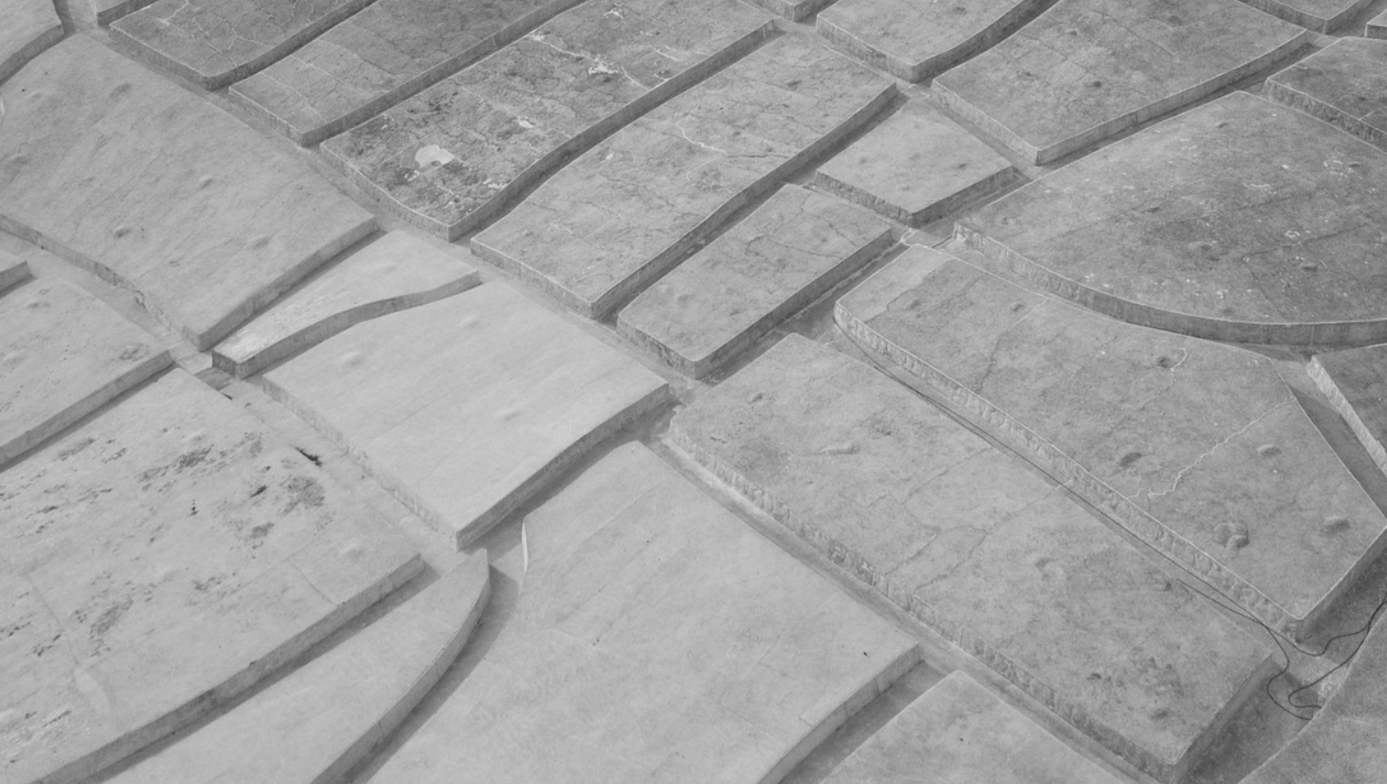The #iziTRAVELSicilia participatory project and co-production of contemporary art audio guides
Elisa Bonacini, PhD
The Museum Review, Volume 5, Number 1 (2020)
Abstract This paper addresses participatory strategies and the co-production of museum and city audio guides through izi.TRAVEL, a free digital storytelling platform and app. This article explores contemporary art audio guides, which have been part of a large-scale regional project launched as #iziTRAVELSicilia in May 2016. The primary aims for the project were to bridge the digital communication gap, and to enhance Sicilian cultural heritage. #iziTRAVELSicilia soon transformed into a participatory process, involving about 4,000 native Sicilians. Since then, more than 240 audio guides have been created, some of which focus on modern and contemporary art, and some have focused on enhancing the Belice Valley area, destroyed by the 1968 earthquake. As demonstrated by this pilot program in Sicily, izi.TRAVEL could encourage tourists to enjoy cities, landscapes, and cultural resources, becoming an innovative tool for stimulating emotional and creative involvement of people in the co-creation of museum and art-based app content.
Keywords Storytelling; participatory museums; heritage communities; digital heritage; public engagement
About the Author Elisa Bonacini is an Archaeologist, with a BA in Classics and a BA in the Enhancement of Archaeological Heritage, specializing in Classical Archaeology. She has a PhD in Humanities and Cultural Heritage, and was a Research Fellow in the Humanities Department of Catania University, Sicily. Bonacini is currently Courtesy Faculty for the University of South Florida’s Center for Virtualization and Applied Spatial Technologies (CVAST), and a project manager for USF within a digitization project in Sicily. She is also an Affiliated Researcher at the Euro Mediterranean Institute of Science and Technology (IEMEST) of Palermo. Bonacini is the ideologist and the Sicilian regional coordinator for the national project #DigitalInvasions (#InvasioniDigitali) and the regional coordinator for the National Association of Small Museums (APM). She is the regional scientific coordinator for creating participatory multimedia audio guides for museums and for tours on the platform izi.TRAVEL within the Regional Department of Cultural and Sicilian Identity. She has participated in many national and international conferences, and has published books, four of which refer to museums and ICT. A complete list of Bonacini’s publications can be found here: http://usf.academia.edu/ElisaBonacini
Introduction
Jenkins coined the term “participatory culture,” when discussing fandom communities.[1] Participatory culture is reliant on relatively low barriers to artistic expression and on communities’ engagement, featured by strong social connections among members, a belief in single and collective effort for creating and sharing one’s creations with others, and informal mentoring among members, whereby what is known by the most experienced is passed along to novices. New cultural practices are being developed by building communities or affinity spaces where users and members create new content or participate in co-creating content.[2] Thanks to the growing diffusion of the web and digital communication tools including blogs, wikis, and social media, participatory culture and activities grew in a great and global way, based on informal and conversational online communities focused on user-generated content (UGC). These activities include creating and collecting images, text, sounds, and videos to publish, disseminate, remix, and further republish. The UGC are appreciated by users for their authenticity and independence, thus facilitating people’s artistic expression and informal mentorship.[3] New communities have been born, based on participation and collaboration between users, by sharing common interests and socio-cultural and emotional implications in producing, exchanging and disseminating knowledge. This is a new social complex system for our modern 2.0 society.[4]
A specific participatory practice, from which the concept of co-creative UGC emerges, is digital storytelling. Thanks to digital platforms and applications, storytelling and participatory and crowdsourced approaches in the cultural heritage domain is now a trend, giving new life to culture, and is utilized as an influential and valuable communication tool.[5] In this approach, the role of a good storyteller is to create a story that can correctly illustrate content in an exciting and evocative way, which can transform a distracted passerby into a careful observer.[6]
Digital storytelling and crowdsourcing technologies can enable local museums and cultural sites to elevate to national and international standards, creating new cultural, social and economic values. By focusing on the public like never before, they provide a direct impact on cultural institutions by helping to better develop communication and collections management strategies. They have an indirect impact on visitors[7] by creating new experiences with art collections, giving guests more information during visits, providing more complete context and information about local communities, and by creating a stronger sense of awareness and belonging.[8] In this context, participatory platforms are gaining ground in social sectors like culture, sociology and education, and also in market sectors like tourism, representing an important marketing tool for territorial promotion. This paper will analyze innovative tools used for culture dissemination and promotion through participatory web platforms by exploring the global free storytelling platform izi.TRAVEL (https://izi.travel/en).[9] This platform is based on the democratization of cultural content and languages (fig. 1).
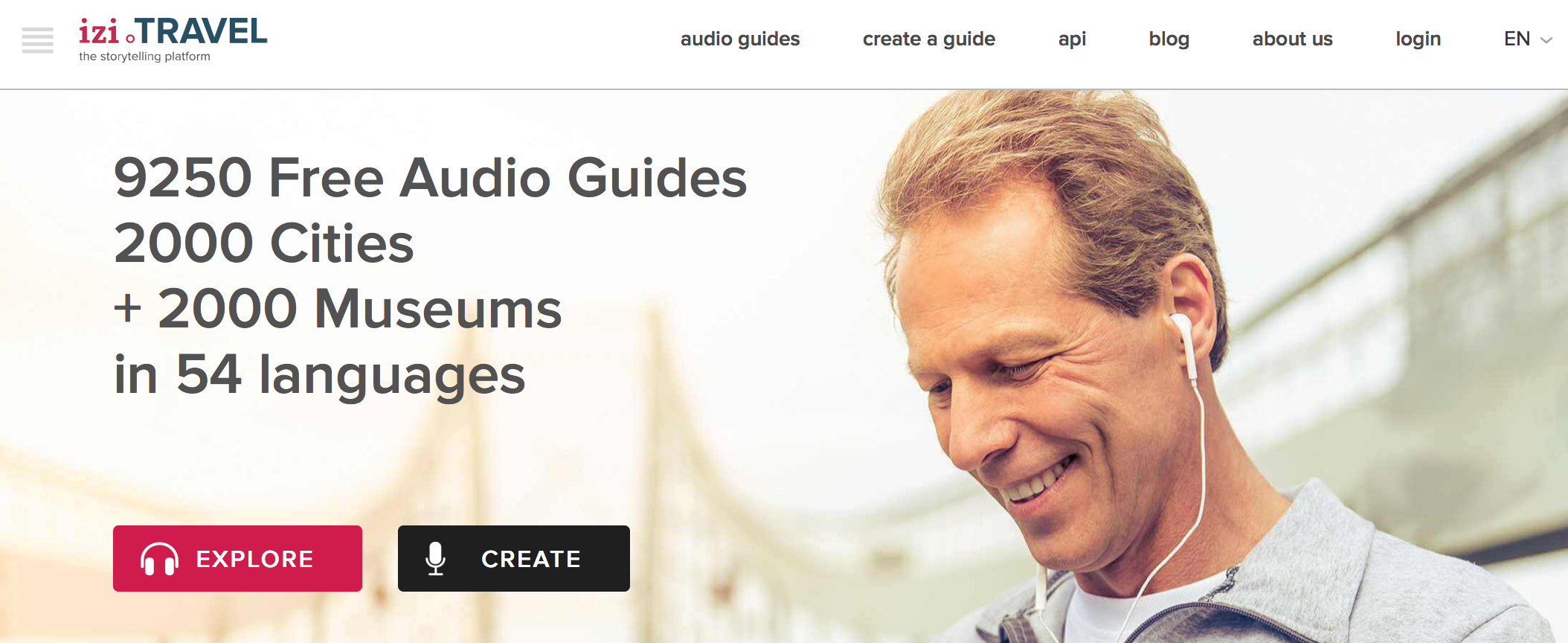
The role of cultural and tourist apps and other storytelling platforms is significant, but pushing people toward emotional and creative involvement in the co-creation of cultural content is even more significant. The role of digital storytelling participatory platforms in encouraging curators and local residents to co-create and to share cultural content, knowledge, and narratives through storytelling is notable given they are concentrating their collective efforts on creativity.
This premise leads us to recognize the value of cultural co-creation in promoting local heritage, and the social integration and cohesion for local heritage communities. The #iziTRAVELSicilia case study will help demonstrate this benefit of new technology on participatory digital culture.
The author believes that this successful experience is a new best practice for a social and sustainable action that promotes wide participation in co-creating cultural content and values, joining local people in smart “heritage communities” as assessed by the Council of Europe.[10] The #iziTRAVELSicilia project is a socially and culturally sustainable heritage action in the manner that cultural institutions are able to create a culture of participation around their digital collections. Specifically, this paper will show how participatory methods and storytelling techniques have been used for creating contemporary art audio guides.
izi.TRAVEL: a global storytelling platform
izi.TRAVEL is a multilingual global storytelling platform, founded in Holland in 2011 and launched as a start-up in 2013.[11] As shown in Figure 2, an average 110 million annual users, and 9 million monthly users of the app, izi.TRAVEL is the most important global, open, bottom-up and free platform based on storytelling. Founded to help heritage and tourist organizations bring their stories to life, it permits users to create free audio guides. It offers 10,000+ city tours (fig. 3) and 2,200+ museum audio guides (fig. 4), totaling 12,500 tours.
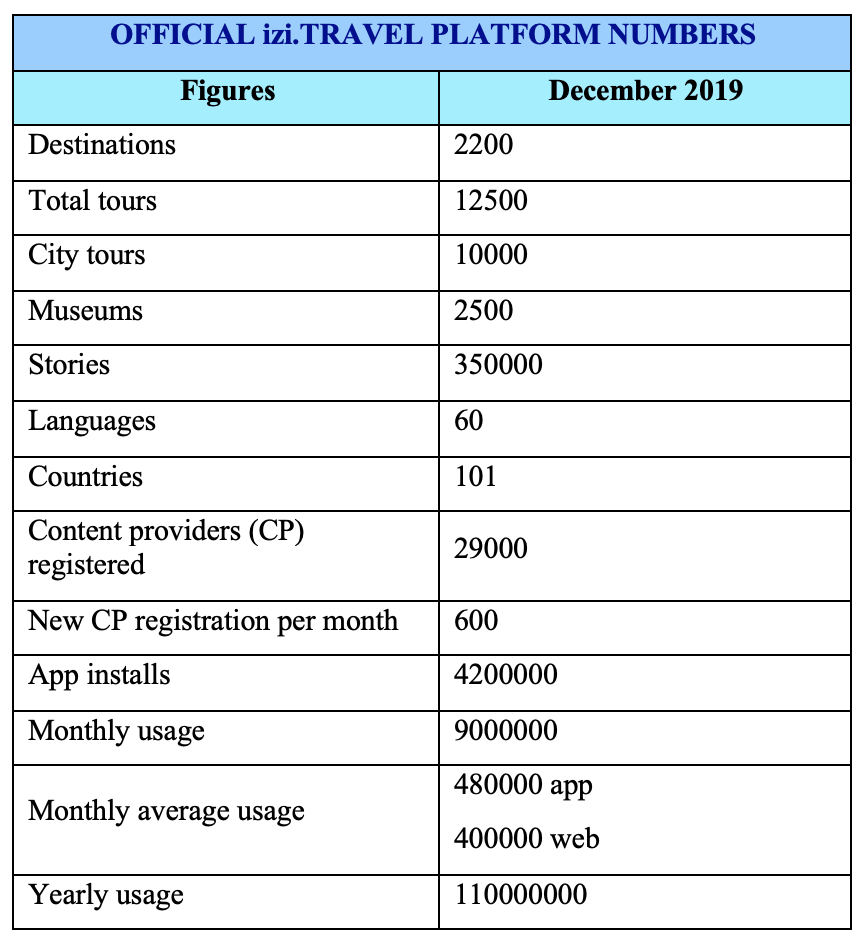
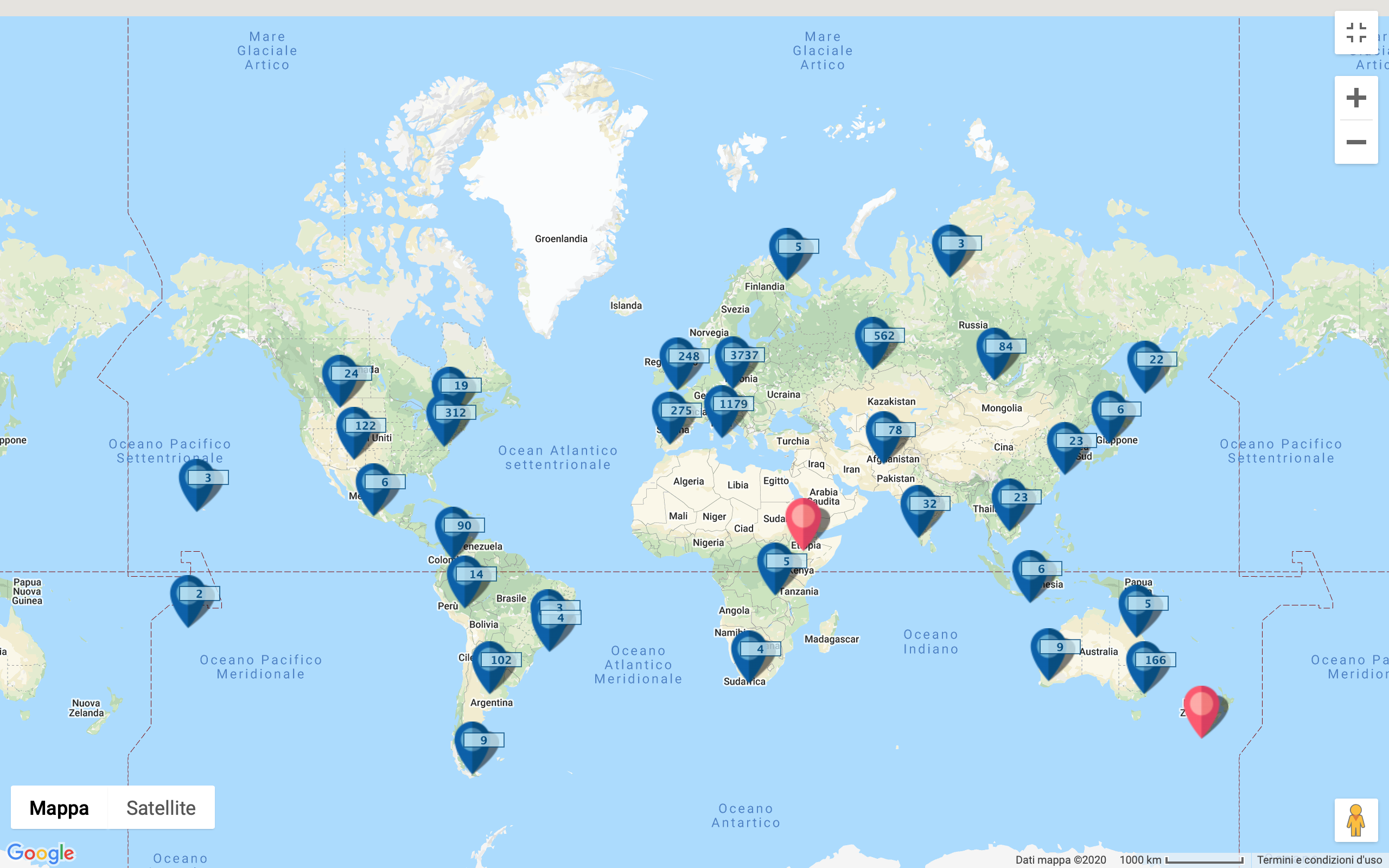
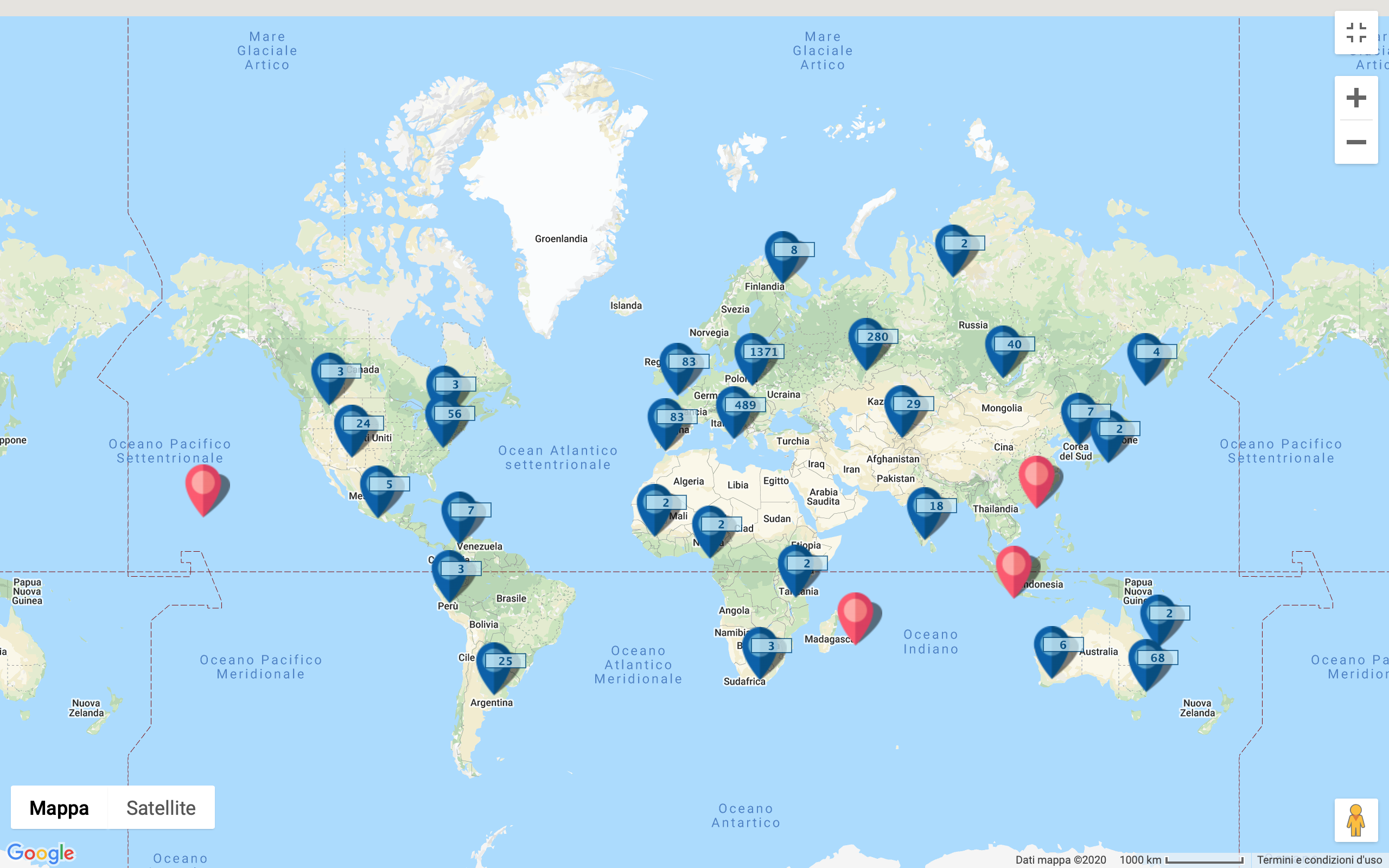
The cost-free app, installed 4.1 million times, is available on the Apple App, Google Play, and Windows Phone stores, with destinations in 101 countries and in 60 languages.
Each audio guide can be viewed online by exploring the web platform via countries or through a manual search. Mobile phones enable searching via the app, Google Maps, by searching for countries, by scanning QR-Codes, or with GPS triggering in situ. This way, the app allows people to discover cultural sites using their smartphones, receiving stories in the right location. Moreover, every audio tour can also be used in offline mode if stories are downloaded in advance.
Based on digital participatory culture and storytelling, izi.TRAVEL aims to democratize and promote culture and territories, enabling users to tell and promote a territory through its most varied expressions. It also can be considered as a digital tool for itinerary planning or for further site study. izi.TRAVEL was designed to be flexible, intuitive, and friendly, allowing both institutions and people to develop projects about heritage, and to manage or to add their own materials or self-generated content.
izi.TRAVEL offers users the opportunity to easily create a multimedia audio guide through the izi.TRAVEL content management system (CMS). Information about creating a museum audio guide or city audio tours available on the izi.TRAVEL blog[12] or on the izi.TRAVEL Academy[13] populated with video courses like cartoon or storytelling video tutorials located on izi.TRAVEL’s official YouTube channel.[14]
Content providers (CP) (whose publishing profiles are clearly distinguishable as institutions, tour operators, or users) can create audio guides by adding text, audio content, photo galleries, and videos (linked to YouTube or uploaded by the CP), which can be transformed into a hypertextual guide with web links. This can make museum visits or discovering a city more enjoyable and enriching experience. With a single profile, a CP can produce and manage an unlimited number of audio guides. Intellectual and data property rights remain with the content provider. izi.TRAVEL is only concerned with providing the CMS.
Among the innovative elements, the izi.TRAVEL platform and app allow destinations to be discovered in multiple ways: during pre-fruition and post-fruition phases, on-site, on the web and via the app, by GPS activation, or by geolocating on Google Maps, allowing users to reach a destination, to discover new information about places, and to select all audio guides or points of interest mapped on Google.
izi.TRAVEL allows people to discover places and to access all the published audio guides through the “Explore” section and the izi.TRAVEL menu organized by country, region, and city. It allows users to discover destinations and stories through four types of media content: audio, text, video, and photographs. In the app, a free walking mode is automatically activated by GPS. Registered app users can bookmark content and synchronize the results or download favorite audio guides in order to have each available in off-line mode in the “Download” section. Users can create and geolocate a single story as a “tourist attraction,” uploading text, photos, and audio recordings. From the “Scan QR” section, izi.TRAVEL allows users to directly scan QR codes. The app is directly connected with the major social media outlets, and users can leave feedback and comments. Institutions and users can share content on Facebook, Twitter, or via email.
Case study: #iziTRAVELSicilia
“Sicilia Beni Culturali” on izi.TRAVEL was an annual research project at the University of Catania underwritten by izi.TRAVEL in its first year, and now exists without additional external funding.
The project’s primary goal was to utilize izi.TRAVEL as a tool to improve digital content for cultural heritage promotion, filling the well-documented gap of Sicilian cultural heritage communication.[15] The second aim was to establish best practices for participating in and co-creating digital cultural content around museums and institutions by developing cultural participation, citizenship, and social cohesion, and by promoting new relationships between people and their heritage. According to the concept of “heritage communities” highlighted by the Convention on the Value of Cultural Heritage for Society, known as the Faro Convention,[16] museum audio guides and city audio tours have been created by involving diverse people and by strengthening synergies between them.
A large-scale regional project was launched in May 2016 under a cooperative agreement between the Department of Cultural Heritage and Sicilian Identity and the University of Catania. It aimed to co-create cultural audio guides under a single regional-level coordinator, represented by this paper’s author.
At the beginning of the project, seven guides existed (fig. 5). After about four years, izi.TRAVEL audio guides in Sicily total 240+ (fig. 6), out of 1,050 total audio guides available in Italian on the entire platform. Sicily accounts for roughly 2,500 tourist attractions (fig. 7) of the 12,500 on the platform.
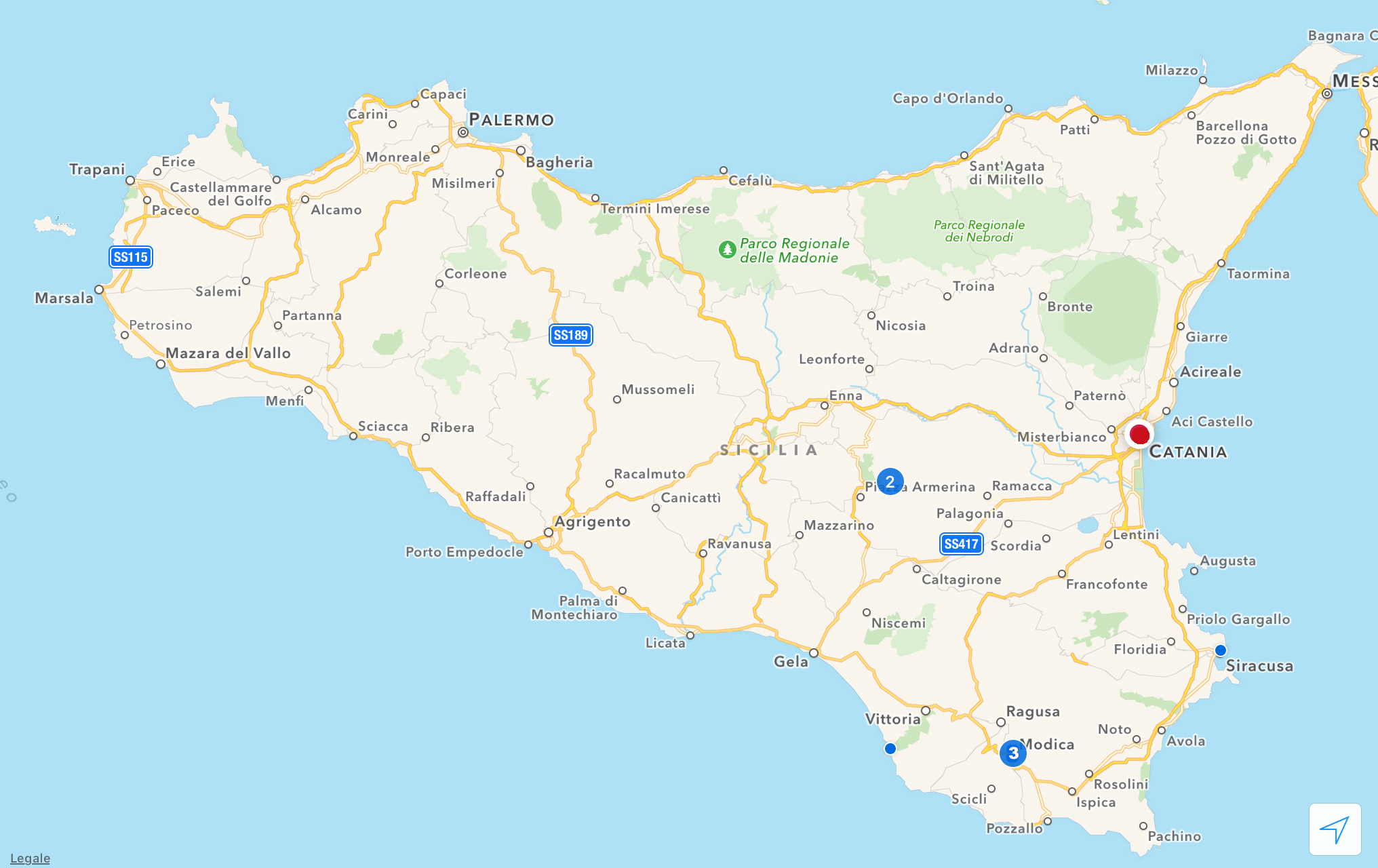
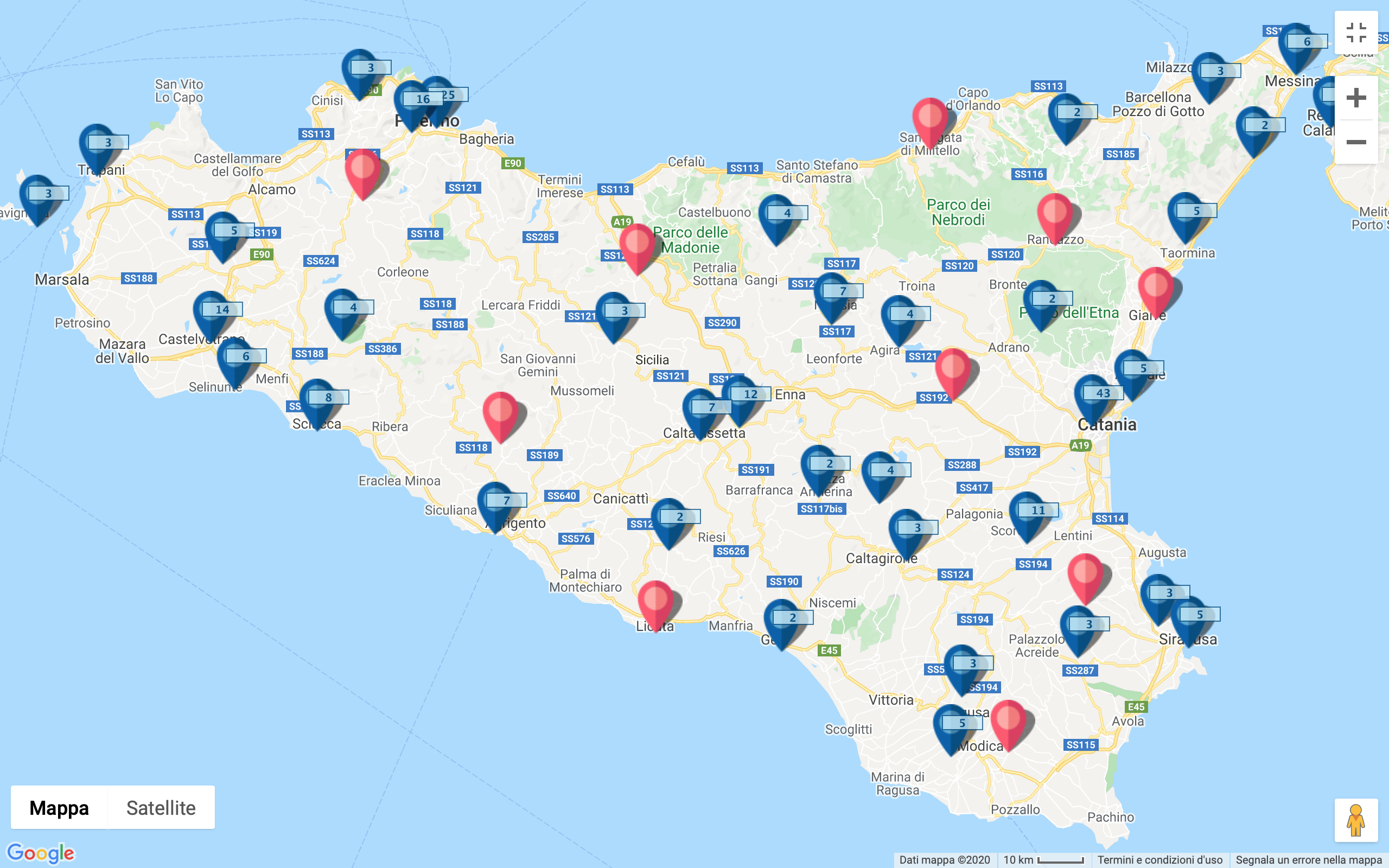
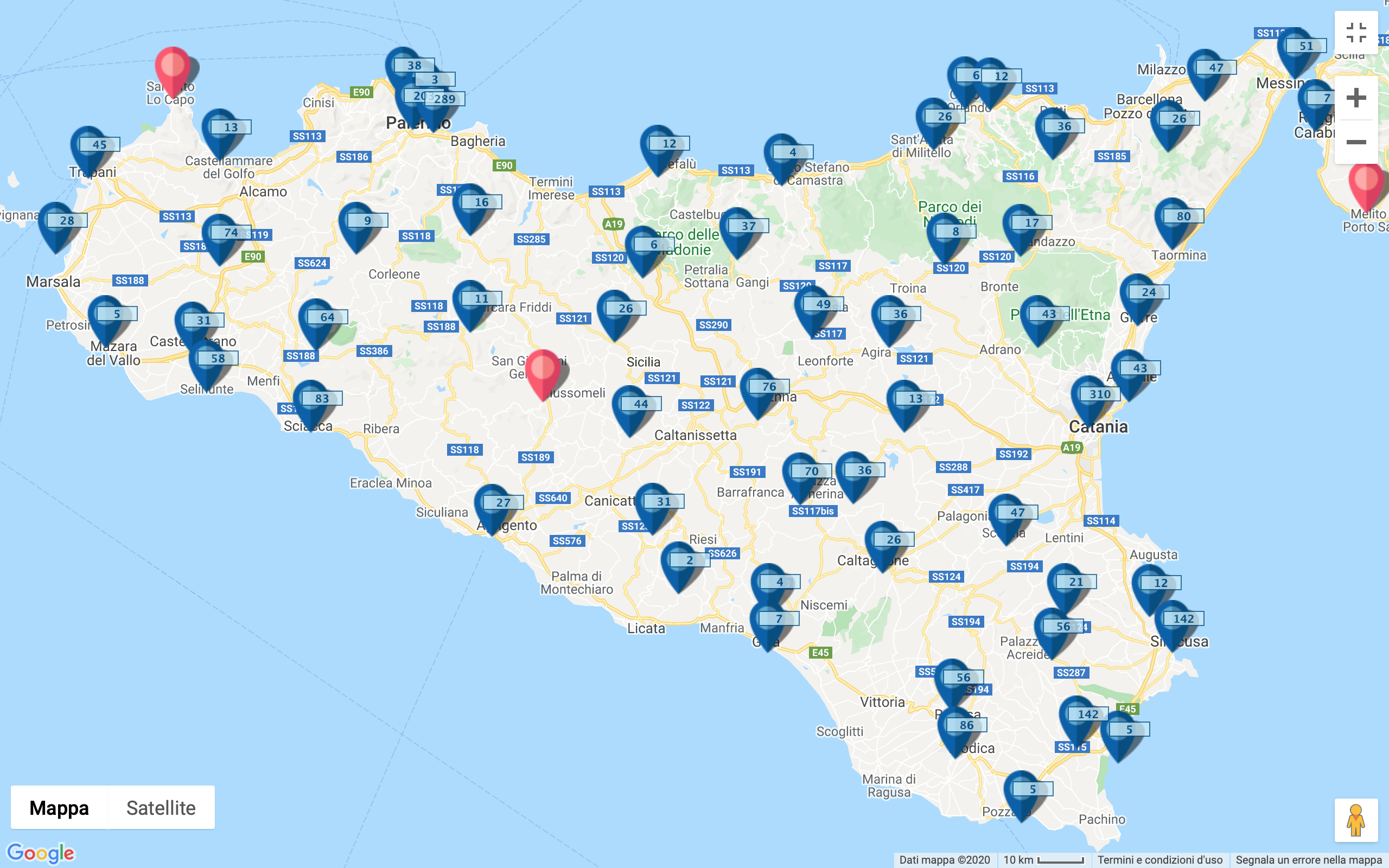
#iziTRAVELSicilia can now be considered a best practice method for local promotion on the izi.TRAVEL platform. This regional-scale process enabled the participation of 4,000+ people, who became storytellers of their own heritage like they were “digital Ciceroni.” Individuals ranging from school children to museum directors co-created cultural content, highlighting the importance of the role community-based initiatives have in enhancing local culture and attractions through user involvement and knowledge sharing.[17]
Every authority that published an audio guide certifies all content produced. People who contributed to the creation of audio guides are credited by name in the content summaries and on the platform.
The participatory co-production of contemporary art audio guides
Convinced that this opportunity should be offered as widely as possible in Sicily, the writer chose to involve all the heritage communities willing to join the project: municipalities, museums, varied institutions, museum networks, associations, cultural and tour operators, schools, the Universities of Catania and Palermo with laboratory projects, graduate workshops, and those working on undergraduate, graduate, or doctoral theses.
With support and coordination, a network of storytellers was created. Together, the participants overcame the concept of heritage ownership, embracing instead the concept of common cultural heritage. It was promoted through a bottom-up, widely-disseminated and participatory process to guarantee the common right to cultural heritage, as the Faro Convention requires.
Some of the 240 audio guides published within this project were produced in order to enhance Sicily’s modern and contemporary art collections. The contemporary art projects carried out by Sicilian high school and university students, by the Museum Network of the Belicina Valley, and by some contemporary art institutions, such as the Orestiadi Foundation and Palermo’s Palazzo Riso Museum of Contemporary Art, will be discussed below.
Contemporary art audio guides
Many projects were carried out with Sicilian high schools within the ministerial program entitled Alternanza Scuola Lavoro (School-Work Alternate), and were realized in collaboration with local authorities (municipalities, associations, museums, etc.). After training workshops explaining both the project on the izi.TRAVEL platform and its CMS, local students contributed to the digital promotion and enhancement of their cultural heritage.
Numerous entries were made at Castelvetrano, near Selinunte, in the area of Trapani. Students from the Comprehensive Institute M. Cipolla – G. Gentile – G. Pantaleo three Lyceums (Scientific, Human, and Classical Sciences) worked in synergy with municipalities and associations to create the Gibellina en plein air[18] audio tour, and the Di Stefano House’s Granary audio guide.[19]
These Lyceum students who addressed contemporary art in the newly-rebuilt town of Gibellina, experienced cognitive and emotional growth. They examined their geographic area’s urban and social lacerations suffered in the devastating 1968 Belice Valley earthquake, which destroyed many cities. The newly-rebuilt town of Gibellina, about 20 kilometers from the city’s original location, is dotted with contemporary works of art that artists of national and international renown. Invited by mayor Ludovico Corrao, these artists donated works to the city in order to revive its reconstruction, as a symbol of rebirth.
The first stop of the Gibellina en plein air audio tour is the Cretto di Burri (or Crack of Burri), a land-art cement sculpture made by Alberto Burri in 1984, left unfinished in 1989, and finally completed in 2015 (fig. 8).
Old Gibellina lies down there…The artist wanted to seal that immense expanse of rubble and pain with an equally immense pour of cement. The “fractures” you see in the cement have a precise meaning: they want to keep the memory of the ancient roads, passing on to future generations the historical memory of the town.
The Gibellina audio tour continues to Pietro Consagra’s Belice Gate (1981) – an enormous stainless steel door in the shape of a staircase, used as an emblem of the new city of Gibellina.
From this “point of interest,” the tour offers a catalog of thirty-five additional works of art scattered across the new Gibellina. The students made a thorough census of the works of art in the open air museum of Gibellina. Further, they contributed to its photographic and video documentation, including an introduction to the Gibellina tour[20] and the Cretto di Burri.[21]
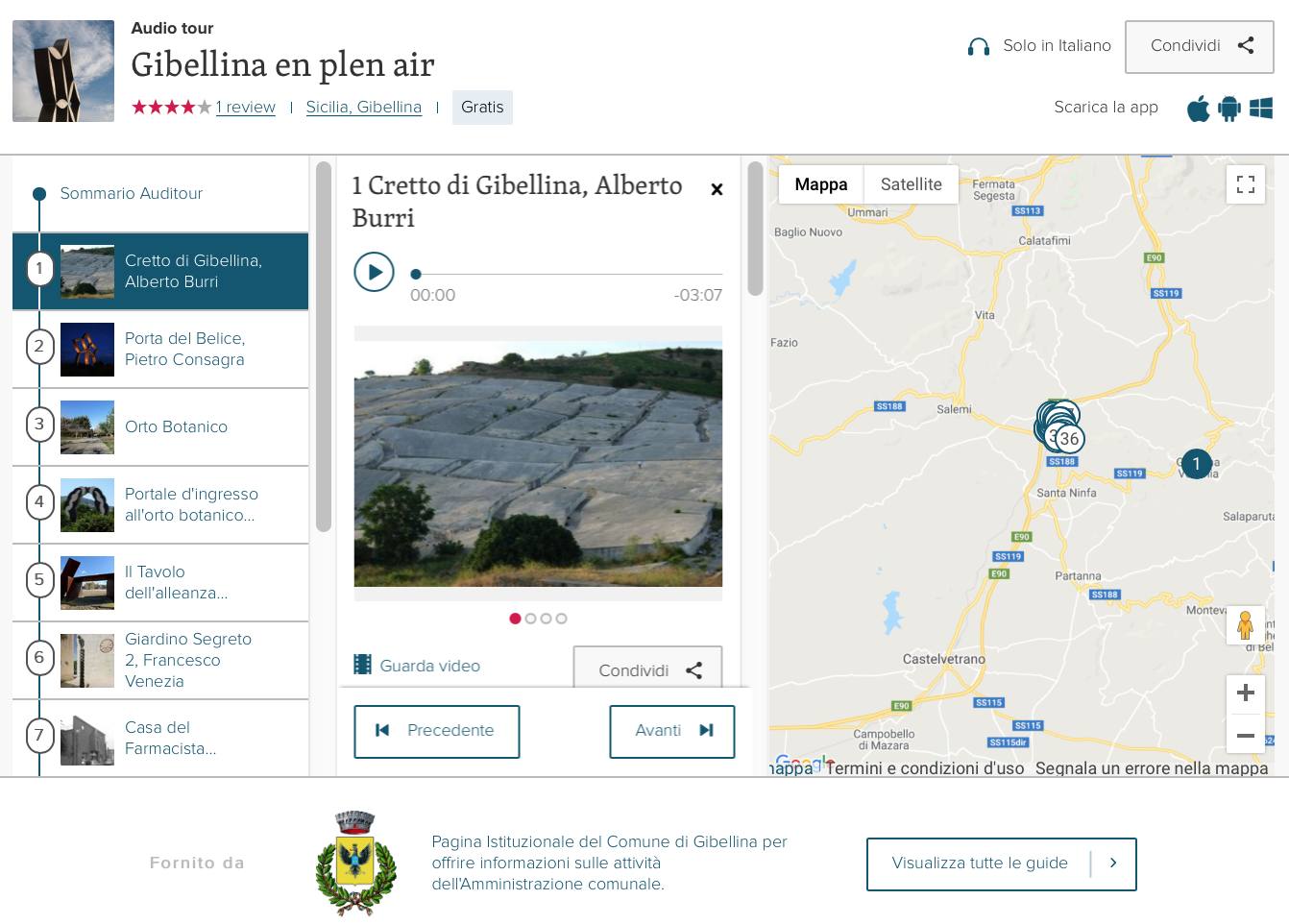
The Baglio di Stefano, an 18th century farmhouse purchased and restored by the Municipality of Gibellina after the 1968 earthquake, is today the seat of the prestigious Orestiadi Foundation Higher Institute. It houses the Museum of the Mediterranean Wefts, which collects decorative art objects including costumes, jewelry, fabric, ceramics, and objects of art of the peoples and cultures of the Mediterranean. The museum documents what binds together the people who live around this area. The Granary houses the museum’s contemporary art collection, the most significant works of which were donated by international artists who used Gibellina as an artistic laboratory. The students documented roughly 60 works of art from the collection, produced biographic and artistic material, produced an introductory video,[22] and included a set of photographs.
A class of students at the Academy of Design and Visual Arts in Sant’Agata li Battiati (Catania) produced five audio tours during a course focused especially on modern art and photography. One of the five they created is a regional-scale audio tour: Places of Architecture and Design in Sicily (I luoghi dell’Architettura e del Design in Sicilia).[23]
The students created a tour that included nine points of interest, and began with an interview with Harvard Graduate School of Design President, Mohsen Mostafavi, about the relationship between architecture and design. The students focused on specific places restored using modern design, such as the Steri and Abatellis Palaces, designed by well-known architect Carlo Scarpa, and the Benedictine Monastery in Catania, by Andrea De Carlo. The Belice Valley, again, is one of the main protagonists, housing working of art including Alessandro Mendini’s Clock Tower (1987) located in Gibellina’s new main square. The artist digitally marks the time five times a day (at 6:00, 8:00, 12:00, 17:00, 20:00) using sounds consisting of Sicilian folk songs and sounds characteristic of daily life from old Gibellina, like noises made by street vendors.
Catanese student, Cecilia Chisari, at the University of Macerata in the Marche region, created a guide of the Emilio Greco Museum in collaboration with museum staff for her BA thesis.[24] The guide is an instrument to understand the artist and his artistic production. The guide is divided into three sections (“Who was Emilio Greco?,” “The Museum,” and “Artistic production”), and explain lithography and etching techniques, and utilize two YouTube videos.
Eighteen audio tours have been produced in collaboration with four of the five Sicilian Museums Networks: the Network of Ethno-Anthropological Museums in the province of Messina (1 general tour),[25] the Hyblaean Culture Museums Network (1 general tour),[26] the Museums and Natural Network of the Belicina Valley (1 general tour and 5 thematic tours),[27] and the Museums, Cultural and Environmental Network of the Central Sicily (1 general tour and 9 thematic tours).[28]
A collaboration between Sicily’s regional cultural hubs and museums produced a significant number of audio guides. The Rocca Reina Art Factory and it’s wonderful Andromeda theater, provide an example of the evocative work now found on the izi.TRAVEL site:
…a place where art and pastoralism merge: it is the educational farm, art workshop, museum, and at the same time sheepfold created by Lorenzo Reina, sculptor and shepherd […] Here, Lorenzo is always ready to welcome, to open a dialogue […] Among his great works are the Theater and the Museum. These works of architecture are created in perfect harmony with the surrounding landscape, and attest to the skill of the craftsman […] The museum itself is a work of art. It is an octagonal building inspired by the famous Castel del Monte (Puglia), one of the greatest expressions of the architecture of Emperor Frederick II of Swabia. […] A deep symbolism also revolves around the original and unexpected structure of the Andromeda Theater […] The structure was built on a hill on the edge of an overhang. The feeling is to be immersed in the landscape. […] The 107 seats seen from above have the shape of an eight-pointed star and have been made by superimposing two square blocks of four sides each. Apparently they seem to be distributed randomly, but in reality they are arranged in such a way as to trace the different points of the Andromeda constellation.
Conclusion
The izi.TRAVEL framework resulted in significant output achieved within Sicilian heritage communities, especially by heritage education programs. According to izi.TRAVEL staff members, no other example exists similar to #iziTRAVELSicilia, in terms of the number of people who participated, the results, the overall coordination, crowdsourcing, and co-creation of content, and storytelling techniques, presented by the native Sicilians. Thanks to this project, which can be considered highly experimental and highly collaborative, Sicily has become the only region in the world to experience a large scale coordinated participatory, democratic, and horizontal content creation process.
Through these audio guides, #iziTRAVELSicilia tried to bring the user closer to contemporary art, simplifying language, making artists approachable, and trying through evocative narration, to subvert the distance between those who have been trained and have specific knowledge, and those who traditionally do know have that knowledge base, and are therefore excluded from understanding and describing art. Sicilian students were the protagonists in this experiment. The narratives Sicilians created assisted in their own heritage education, and by disseminating this information, iziTRAVEL became a formidable instrument of inclusivity, creating a sense of community belonging while cultivating participation in an active and smart society.
References
Bakhshi, Hasan and Throsby, David, “New technologies in cultural institutions: theory, evidence and policy implications,” International Journal of Cultural Policy 18, No. 2 (2012): 205-222. Accessed February 27, 2013.
Bonacini, Elisa. La visibilit@ sul web del patrimonio culturale siciliano. Criticità e prospettive attraverso un survey on-line. Catania: Giuseppe Maimone Editore, 2012.
Bryan, Alexander. The new digital storytelling: creating narratives with new media. Santa Barbara: Praeger, 2011.
Carmosino, Cinzia, “La Convenzione Quadro del Consiglio d’Europa sul valore del patrimonio culturale per la società,” Aedon. Rivista di arti e diritto online 1 (2013). Accessed August 12, 2018.
Ciasullo, Maria Vincenza, Gaeta, Angelo, Gaeta, Matteo and Monetta, Giulia, “New modalities for enhancing cultural heritage experience. The enabling role of digital technologies,” Sinergie Italian Journal of Management 34, No. 99 (2016), 119-138. Accessed December 12, 2016. http://sinergie.kaleidoscope.it/wp-content/uploads/2018/04/1207-1912-1-PB.pdf
Cobo Romani, Cristóbal and Moravec, John. Aprendizaje invisible: hacia una nueva ecología de la educación. Barcelona: Universitat de Barcelona, 2011.
Council of Europe. “Council of Europe Framework Convention on the Value of Cultural Heritage for Society. Council of Europe Treaty Series, No. 199.” Accessed July 19, 2017. https://rm.coe.int/CoERMPublicCommonSearchServices/DisplayDCTMContent?documentId=0900001680083746
Delwiche, Aron and Jacobs Henderson, Jennifer, “What is Participatory Culture?,” in The Participatory Cultures Handbook edited by Aron Delwiche and Jennifer Jacobs Henderson, 1-9, Routledge: London, 2013.
Drotner, Kirsten and Schrøder, Christian. Museum Communication and Social Media: The Connected Museum. Routledge: London, 2014.
Falk, John and Dierking, Lynn. Museum Experience Revisited. Walnut Creek, CA: Left Coast Press, 2013.
Gee, James Paul and Hayes, Elisabeth, “Nurturing Affinity Spaces and Game-based Learning,” in Games, Learning, and Society: Learning and Meaning in the Digital Age edited by Constance Steinkuehler, Squire, Kurt and Barab, Sasha, 129-153. Cambridge: Cambridge University Press: 2012.
Giaccardi, Elisa. Heritage and Social Media: understanding Heritage in a Participatory Culture. Routledge: London, 2012.
Handler Miller, Carolyn. Digital storytelling. Oxford: Focal Press, 2008.
Jenkins, Henry. Confronting the Challenges of Participatory Culture: Media Education for the 21st Century. Chicago: John D. and Catherine T. MacArthur Foundation, 2006.
Montella, Massimo, Petraroia, Pietro, Manacorda, Daniele and Di Macco, Michela, “La Convenzione di Faro e la tradizione culturale italiana,” Il Capitale culturale 5 (2016): 13-36. Accessed November 24, 2016, doi: 10.138/2039-2362/1549
Palin, Alex and Itro, Daniela, “New no-cost app for museums and city tours. ‘izi.TRAVEL tourist audio guide’ from iziteq turns ordinary tourists into extraordinary travelers.” Paper presented at EVA St Petersburg 2015 Conference Proceedings Electronic Imaging & the Visual Arts, June 24-25, 2015. Accessed July 9, 2016. http://openbooks.ifmo.ru/ru/file/2440/2440.pdf
Roued-Cunliffe, Henriette and Copeland, Andrea. Participatory heritage. London: Facet Publishing, 2017.
Tallon, Loic and Walker, Kevin. Digital technologies and the museum experience. Handheld guides and other media. Lanham: Altamira Press, 2008.
Vaglio, Mariangela Galatea, “Lo storytelling per i beni culturali: il racconto,” in Racconti da museo. Storytelling d’autore per il museo 4.0 edited by Cinzia Dal Maso, 27-51. Bari: Edipuglia, 2018.
Valtolina, Stefano, “A storytelling-driven framework for cultural heritage dissemination,” Data Science and Engineering 1, No. 2 (2016): 114-123. Accessed September 9, 2017.
Van Dijk, Dick, “Exploring Heritage in Participatory Culture: The MuseumApp.” Paper presented at Museums and the Web 2011, Philadelphia, PA, April 6-9, 2011. Accessed May 7, 2018. http://conference.archimuse.com/mw2011/papers/exploring_heritage_in_participatory_culture
Van Ijperenburg, Jura. izi.TRAVEL: the storytelling platform. Breda: NHTV Breda University of Applied Sciences, 2015.
Zagato, Lauso, “The notion of ‘Heritage Community’ in the Council of Europe’s Faro Convention. Its impact on the European legal framework,” in Between imagined communities and communities of practice. Participation, territory and the making of heritage edited by Nicolas Adell, Regina F. Bendix, Chiara Bortolotto and Markus Tauschek, 141-168. Göttingen, Germany: Universitätsverlag Göttingen, 2015. Accessed February 22, 2016. https://books.openedition.org/gup/pdf/220
List of Figures
Figure 1. The izi.TRAVEL homepage. ©Elisa Bonacini
Figure 2. izi.TRAVEL statistics, December 2019. ©Elisa Bonacini
Figure 3. Distribution of the City tours’ audio guides on izi.TRAVEL. ©Elisa Bonacini
Figure 4. Distribution of the Museums’ audio guides on izi.TRAVEL. ©Elisa Bonacini
Figure 5. Distribution of the audio guides in Sicily on izi.TRAVEL (May 2016). ©Elisa Bonacini
Figure 6. Distribution of the audio guides in Sicily on izi.TRAVEL (April 2020). ©Elisa Bonacini
Figure 7. Distribution of the Tourist Attractions in Sicily on izi.TRAVEL (April 2020). ©Elisa Bonacini
Figure 8. The Gibellina en plein air audio tour on izi.TRAVEL. ©Elisa Bonacini
Notes
[1] Jenkins, xi-xv.
[2] Gee and Hayes, 129-130.
[3] Giaccardi; Delwiche and Henderson, 1-2; Drotner and Schrøder, 1-8.
[4] Romani and Moravec, 47-74.
[5] Miller, 3-20 and 53-86; Bryan, 225; Van Dijk; Giaccardi, 199-207.
[6] Vaglio, 29-30.
[7] Bakhshi and Throsby, 4-7.
[8] Tallon and Walker, 34-38; Falk and Dierking, 288; Ciasullo, et al.
[9] See https://izi.travel/en
[10] Council of Europe (2005).
[11] Palin and Itro; Van Ijperenburg.
[12] See https://izi.travel/en/blog
[13] See https://academy.izi.travel
[14] See https://www.youtube.com/channel/UCvidztWMbxuJ3hArkZIaIhg
[15] Bonacini, 254-260.
[16] Carmosino; Zagato; Montella, et al, See Appendix, 205-214.
[17] Valtolina, 114-115; See examples of user involvement in Roued-Cunliffe and Copeland.
[18] See https://izi.travel/it/7030-gibellina-en-plen-air/it
[19] See https://izi.travel/it/991a-granaio-delle-case-di-stefano/it
[20] See the video here: https://media.izi.travel/42ea8501-aab7-443b-aba4-4cc966ee4779/047e9714-038b-432e-a30d-c349bc44be67.mp4
[21] See the video here: https://media.izi.travel/42ea8501-aab7-443b-aba4-4cc966ee4779/2c9b5b8b-a8b1-4bd5-85b8-b2b60ae82046.mp4
[22] See the video here: https://media.izi.travel/42ea8501-aab7-443b-aba4-4cc966ee4779/cc349d94-bd26-4826-943c-5bf7dc093d33.mp4
[23] See https://izi.travel/it/dd50-i-luoghi-dell-architettura-e-del-design-in-sicilia/it.
[24] See https://izi.travel/it/7c6e-museo-emilio-greco/it
[25] See https://izi.travel/en/e712-i-musei-etnoantropologici-della-provincia-di-messina/it.
[26] See https://izi.travel/en/8ceb-la-rete-museale-della-cultura-iblea/it
[27] See all the audio guides here: https://izi.travel/en/8aed-rete-museale-e-naturale-belicina/it
[28] See all the audio guides here: https://izi.travel/en/bda9-rete-museale-culturale-e-ambientale-del-centro-sicilia/en



